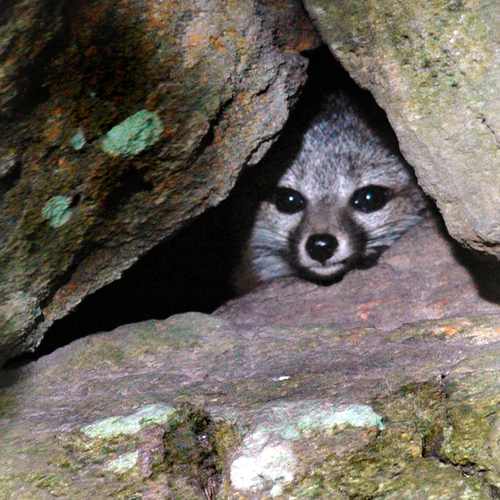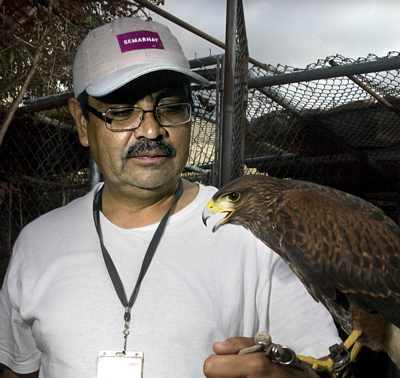|
By John Pint
 Snakes,
owls, raccoons, falcons, crocodiles, bats and tarantulas: you’ll find
all of them and a lot more at Guadalajara’s Centro para la Conservación
e Investigación de la Vida Silvestre (Wildlife Center, popularly
referred to as CIVS, pronounced “seebs”), located near the city’s
Estadio de Futbol. The Center, however, is not a zoo. All its 365
guests are “displaced individuals,” exotic animals either abandoned by
their owners, found wandering about or deliberately confiscated from
people mistreating them. Whatever the case, all of them end up in the
attentive care of a foster father: Andrés González, Director of CIVS
Jalisco. Snakes,
owls, raccoons, falcons, crocodiles, bats and tarantulas: you’ll find
all of them and a lot more at Guadalajara’s Centro para la Conservación
e Investigación de la Vida Silvestre (Wildlife Center, popularly
referred to as CIVS, pronounced “seebs”), located near the city’s
Estadio de Futbol. The Center, however, is not a zoo. All its 365
guests are “displaced individuals,” exotic animals either abandoned by
their owners, found wandering about or deliberately confiscated from
people mistreating them. Whatever the case, all of them end up in the
attentive care of a foster father: Andrés González, Director of CIVS
Jalisco.
When asked in an interview to mention all the
animals that have found their way to the Center, González smiled. “You
name it! We’ve seen just about everything here from lions to
scorpions.” As for what happens to these creatures once they reach
CIVS, González explained that the Center’s primary aim is to return as
many of these animals as possible “back to nature,” but never ignoring
what is best for each individual animal. “For example,” he said, “many
of these creatures were raised as pets and have either been imprinted
on human beings or have never learned to survive in the wild.”
 In
such cases, explained the Director, the animals may be turned over to
an UMA or Unidad de Manejo Ambiental (environmental management unit).
“In some cases,” said González, an UMA may be equivalent to a privately
owned animal refuge in the USA, but it could also be an organization or
individual raising and selling animals for commercial purposes.
Whatever the case, an UMA must conform to the norms of CITES, the
Convention on International Trade in Endangered Species of Wild Fauna
and Flora, to which Mexico subscribed in 1976.” In
such cases, explained the Director, the animals may be turned over to
an UMA or Unidad de Manejo Ambiental (environmental management unit).
“In some cases,” said González, an UMA may be equivalent to a privately
owned animal refuge in the USA, but it could also be an organization or
individual raising and selling animals for commercial purposes.
Whatever the case, an UMA must conform to the norms of CITES, the
Convention on International Trade in Endangered Species of Wild Fauna
and Flora, to which Mexico subscribed in 1976.”
In some cases,
when the animal has been taken away from a cruel or careless owner,
litigation to get it back may ensue. Because Mexican court cases could
take years to resolve, the animal cannot be sent to an UMA and may end
up a permanent resident of CIVS for the rest of its life.
As is
sometimes the case in government institutions, the budget of CIVS is
not nearly enough to cover expenses. Andrés González, therefore, keeps
costs down by encouraging students and others to volunteer to feed and
care for the animals. Students like bat specialist Carla Carolina find
that the ambience of the Center is so welcoming and uplifting that they
just keep coming back. “Only two of us are paid staff members,” says
González, gesturing toward the next room, filled with busy people.
“Everyone else you see here is a volunteer.”
The two people on
the staff, González and his right-hand man, Ernesto Ramos, also cut
costs by manufacturing their own equipment, such as falcon hoods and
coyote collars with built-in transmitters. In addition, the staff
gladly receives food donations for the animals. “You wouldn’t believe
what we need to feed them,” he says: “crickets, mealworms, mice, Gerber
baby food, etcetera.”
Over the years, since its founding in
1985, CIVS Guadalajara has seen its share of adventures. One of the
most recent was the rescue of a crocodile found in the Primavera
Forest. This crocodile ended up a guest at CIVS and was
subsequently released in a suitable environment (on the coast)
along with several other crocs found wandering the streets of
Guadalajara.
“Another strange story occurred about a year ago,”
says the CIVS Director, “when customs agents at the international
airport in Mexico City found a large, unclaimed box full of 500 giant
black African scorpions, all of them pregnant. This species is on the
endangered list and they tried, unsuccessfully, to find an UMA to take
them. When they contacted us about it, we arranged to send the
scorpions to Rodrigo Orozco, here in Guadalajara.” Orozco later
commented that 400 of the 500 scorpions had died in the bodega
(warehouse) where they had been kept. “This is typical of what happens
to innocent creatures at the whim of illegal traffickers,” stated
Orozco, whose UMA is principally dedicated to raising tarantulas in
order to put Mexico’s tarantula poachers out of business (See "Tarantula Man")
Perhaps the most moving story related by Andrés González was that of Arnolda the lioness.
She was being kept at a restaurant in Mismaloya, south of Puerto
Vallarta and had been named after Arnold Schwartzenegger, who starred
in Predator, filmed in the area in 1987. In 1994, CIVS began to receive
reports from customers at the restaurant, especially tourists, claiming
the lion was in terrible condition. CIVS investigated, rescued the
animal and brought it to Guadalajara. “I couldn’t believe what they had
done to that poor creature,” said the Director. “Arnolda weighed only
46 kilos. She had pneumonia and was suffering terribly because her
teeth had been ground down, exposing the roots.”
Arnolda stayed
at CIVS one year, during which her teeth were capped by a volunteer
dentist and her pneumonia was cured. “After a year, Arnolda was fat and
happy,” commented González, “but we couldn’t find any place in Mexico
that would take an adult lion, so we sent her off to a wildlife
organization in California. Aeromexico gave her free transportation to
the USA.”
Andrés González invites the public to call CIVS at 36
09 63 56 in Guadalajara if they want to report the mistreatment of an
exotic animal (sorry, not dogs and cats). “We always have someone
around here who speaks English,” he says. You can call the same number
if you’re interested in lending a hand as a volunteer.

|

